333 Products
-
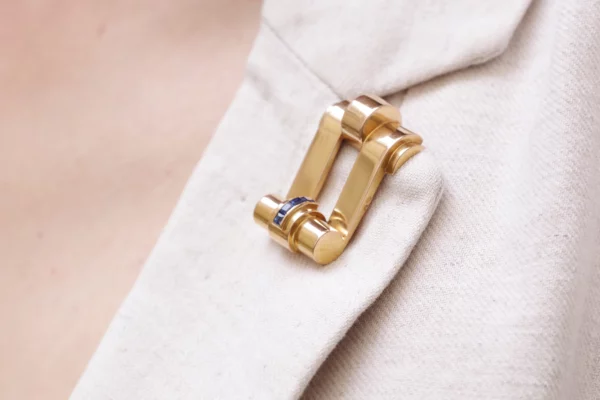
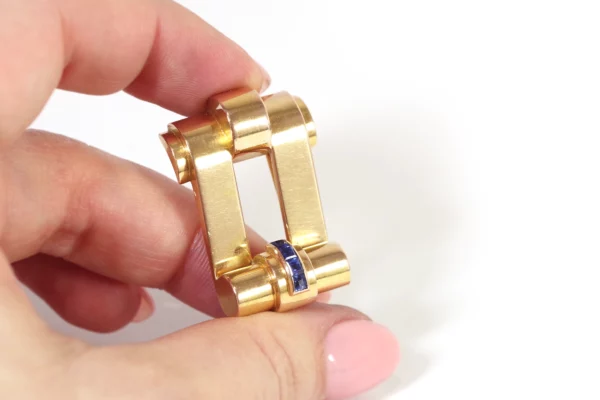 2300,00€
2300,00€Retro French sapphire lapel clip in 18 karat gold. Cylindrical and geometric lapel clip decorated with a line of four calibrated synthetic sapphires. This lapel clip can be worn on a jacket or as a brooch. Dating from the Retro period and designed in the style of Mauboussin, it was made by Louis Heissler, circa 1935/1940 in France.
Eagle head hallmark and hallmark of the Louis Heissler workshop, which worked for Mauboussin from the 1940s to the 1960s, numbered.
Dimensions: 32 x 22 mm
Estimated sapphire weight: 0.08 carat
Condition: light scratches from use
Weight : 10.69 gr
-

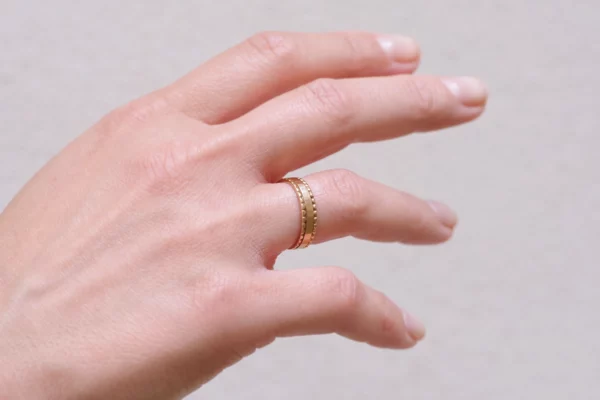 420,00€
420,00€Vintage wedding band in 18 karat rose gold. Wide gold band with faceted decoration and edged with notched friezes. Vintage wedding band, circa 1960, France.
Eagle head hallmark and owl hallmark (french state hallmark for 18 karat gold), hallmark of a silversmith active in the 1960s.
Finger size: 52 EU or 6 US
Ring width: 4 mm
Ring thickness: 1 mmNote: engraving possible inside the ring
Condition : scratches from useWeight : 3.34 gr
-
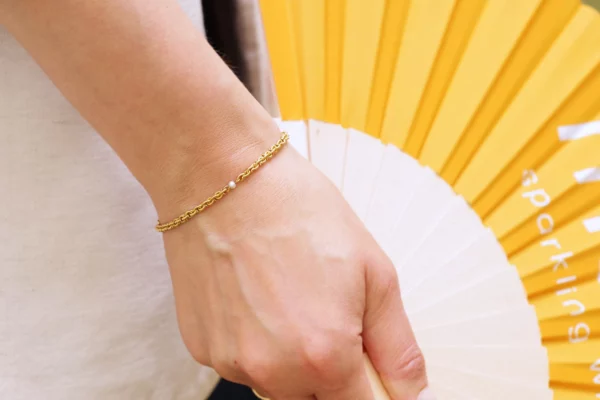
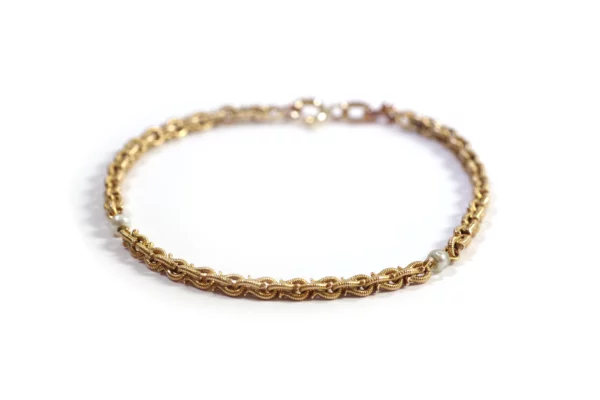 990,00€
990,00€Flexible Victorian bracelet in 18 karat gold. Flexible bracelet made of a beautiful old mesh decorated with striations. It is decorated with two small pearls. Antique bracelet, 19th century, circa 1880.
Weevil hallmarks (french state hallmark for 18 karat gold)
Length : 17 cm
Mesh width: 3 mmNote: we sell a brooch matching this bracelet.
Condition: scratches from use
Weight : 9.42 gr
-
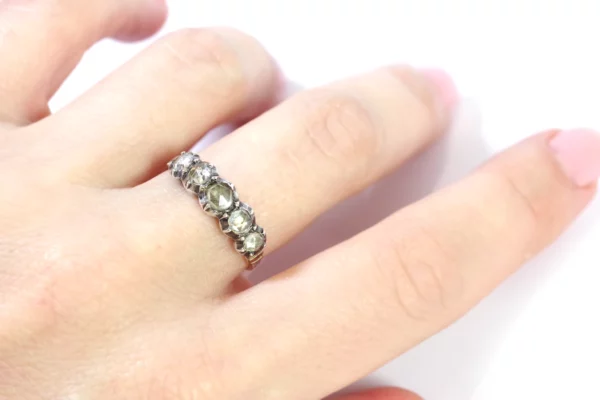
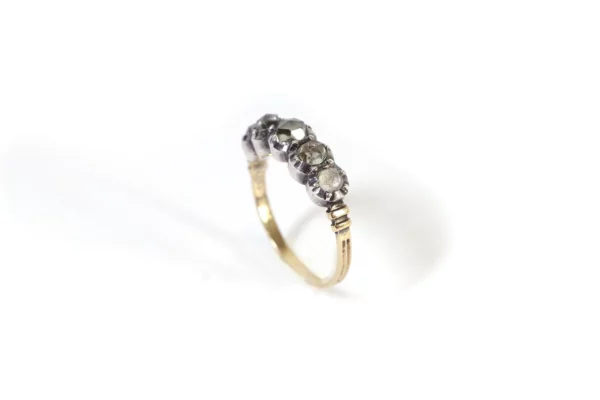 600,00€
600,00€Victorian paste ring in 18 karat yellow gold and silver. Antique ring set with a line of five faceted white paste stones iimitating diamond. Antique engagement ring, circa 1850, France.
Eagle head hallmark (french state hallmark for 18 karat gold) and partially erased goldsmith’s hallmark.
Finger size: 50.5 EU or 5.5 US (resize possible)
Width: 5.5 mm
Condition: scratches from use
Weight : 2.58 gr
-

 1900,00€
1900,00€Belle Époque marquise ruby diamond ring in 18 karats (750) gold and platinum. Belle Époque ring, dating from the early 20th century, entirely set with diamonds of various cuts (old mine cut, rose cut, brilliant cut) and four round synthetic rubies. The ring has a total of 36 diamonds. The stones form a flower motif, with a long petal extending over the finger. Edwardian ring, circa 1900.
Owl and mask hallmark (french state hallmark for 18 karat gold)
Finger size : 57 UE or 7.75 US ( possible to resized)
Estimated total diamond weight: 0.34 carat
Estimated weight of synthetic rubies: 0.10 caratKitten size: 3 cm
Condition: fine wear scratches, old setting, uneven diamond cuts.
Weight : 5.14 gr
-
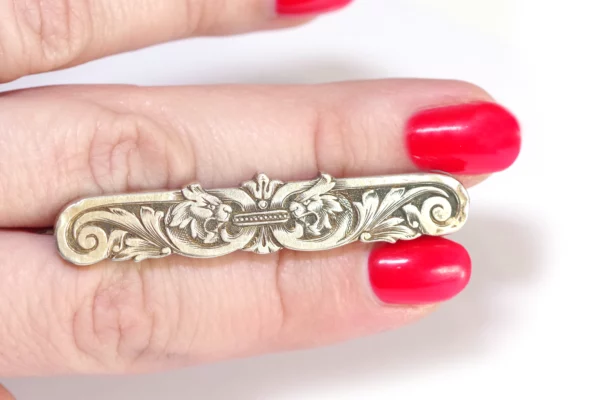
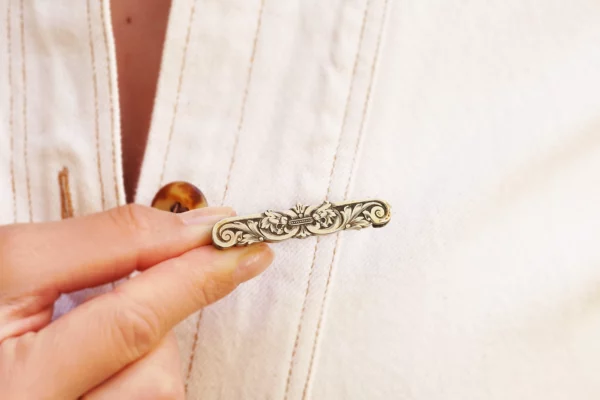 130,00€
130,00€Antique chimeras brooch in gilded silver. Antique bar brooch decorated with two facing chimeras. Late 19th century, France.
Hallmarked with the boar’s head (french state hallmark for silver)
Length: 50 mm
Width: 10 mm
Thickness: 3 mmCondition: signs of wear, old solder repair
Weight: 12.59 gr
-

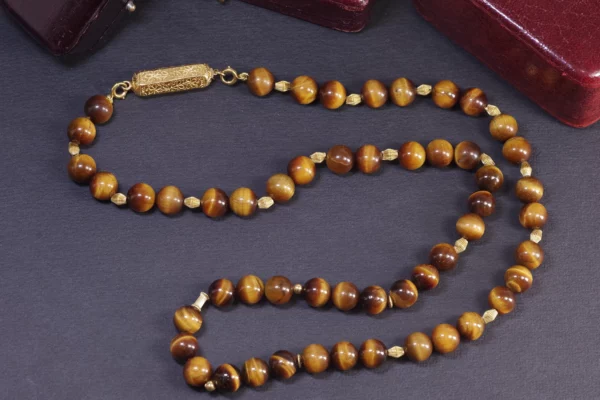 600,00€
600,00€Long necklace of tiger-eye pearls and 18 karat yellow gold (750). Necklace made of 53 tiger-eye quartz balls and 21 gold beads of different shapes. The necklace ends with a large barrel clasp in gilded metal, chased with floral motifs on all facets. It is held in place by two gold spring rings. The tiger’s eye features a gold shimmer that changes with the orientation of the ball. Necklace dating from the ’60s.
Eagle head hallmark on both round clasps.
Length: 69.5 cm
Clasp size: 32 mmPearl diameter: 10 mm
Weight : 94.21 gr
*The antique box is not sold with the jewel*
-
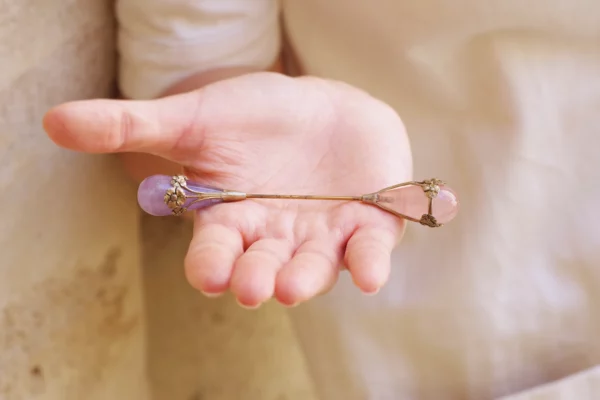
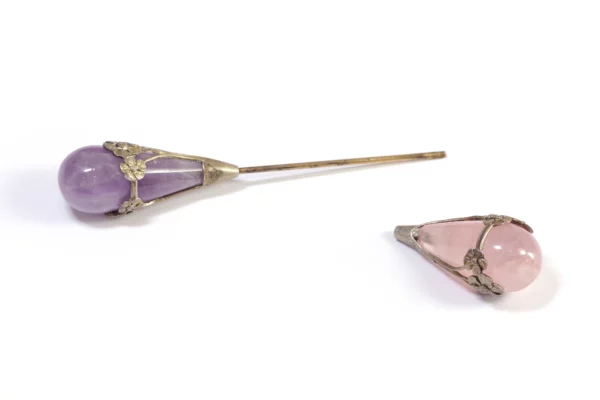 560,00€
560,00€Art Nouveau double hair pin in silver. Art Nouveau pin composed of a rose quartz and a violet quartz (amethyst) in drop form, placed on either side of a silver stem. Both crystals are encircled by silver flowers. This important pin was most likely used to adorn a hairstyle, such as a chignon. Antique double pin, Art Nouveau period, circa 1900, France.
Boar hallmark (french state hallmark for 18 karat gold) and goldsmith’s hallmark.
Length: 12 cm
Quartz dimensions: 3 x 1.5 cmNote: one end screws onto the stem
Condition: crack on one quartzWeight : 24.03 gr
-

 900,00€
900,00€Antique Perpignan garnet brooch in 18 karat rose gold (750/1000). This bar brooch features a series of 11 faceted garnets with a raspberry pink color, arranged in a graduated design. The garnets are bezel-set with V-shaped motifs and have a domed back. Regional brooch from the South of France, circa 1880.
Hallmarked with an eagle’s head and maker’s mark RD
Length: 62 mm
Width: 0.8 mmCondition: dents, wear scratches
Weight: 3.93 gr
-
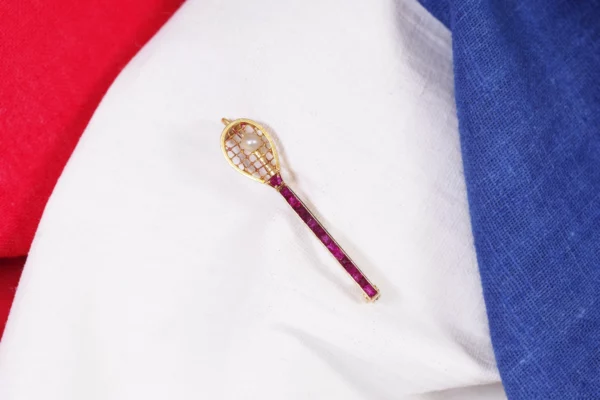
 450,00€
450,00€Art Deco tennis racket brooch in 18 karat yellow gold (750). Brooch in the shape of a tennis racket, with the handle set with 15 calibrated rubies and the strings decorated with a pearl representing the ball. Sports brooch from the Art Deco period, circa 1920. Sport jewelry collection.
Hallmarks: weevils (french state hallmark for 18 karat gold)
Length: 31 mm
Width: 7 mmCondition: light scratches from use
Weight: 1.50 gr
More information : Tennis has been an Olympic sport since the first edition of the modern Olympic Games in Athens in 1896. After being removed from the Olympic program for more than fifty years, it returned at the 1988 Seoul Olympics.
-
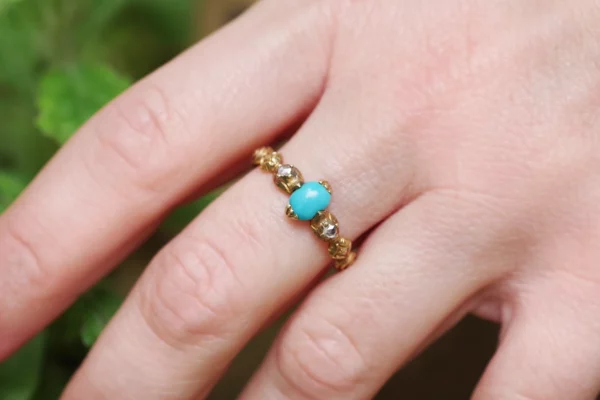
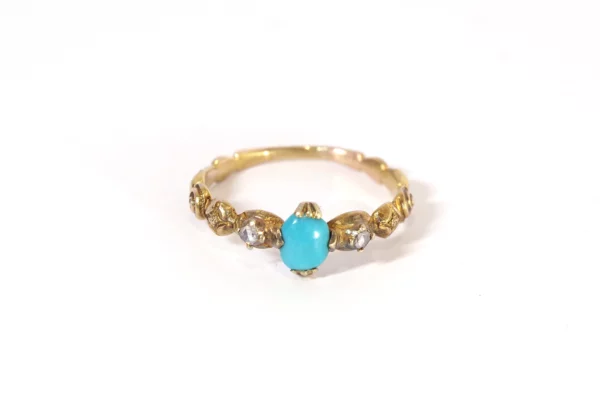 750,00€
750,00€French Georgian ring in 18 karat yellow and rose gold. The ring is adorned with a turquoise blue glass cabochon, flanked by two rose-cut diamonds. The band features rich decoration, including a pine cone, a swirl motif, and a cross pattern. French antique ring, Georgian period, circa 1820/1830.
Hallmarked with a ram’s head (active between 1819-1838, french state hallmark for 18 karat gold)
Ring size: 55 EU or 7.25 US (resizing possible)
Ring head width: 7.33 mm
Condition: fine wear scratches
Weight: 2.56 gr
*The antique box is not sold with the jewel*
-
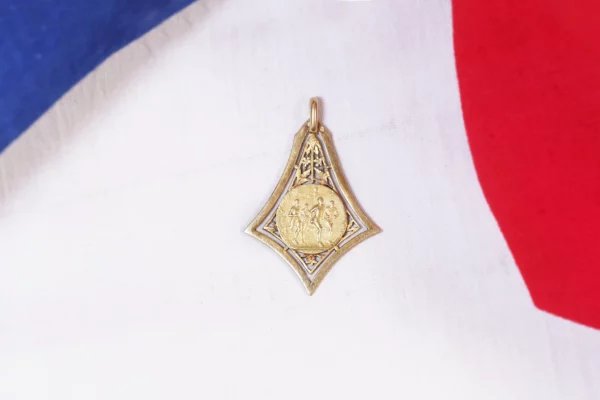
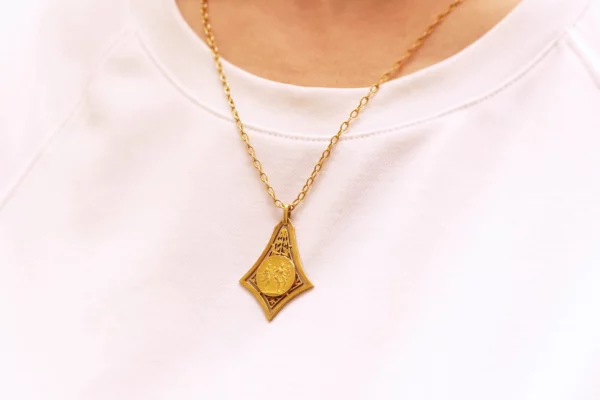 700,00€
700,00€Art Nouveau Athletics medal in 18 karat yellow gold. Art Nouveau pendant centered on a small medal depicting four runners in a 4×1200 meters relay race. The pendant is openwork and decorated with flowers and foliage, typical of the Art Nouveau period. The reverse of the medal bears the inscription “L’intransigeant 17 Dec 1922 Relais 4×1200”. Sports medal pendant, 1922, France. Sport jewelry collection.
Hallmark: eagle’s head and illegible maker’s mark, medallist’s signature H. DEMEY
Height (including bail): 4 cm
Width: 2.7 cmCondition: signs of wear
Weight: 6.12 gr
*The antique gold chain is not sold with the jewel*
See our antique chainsMore information : This piece was awarded to Armand Burtin for the cross-country race of L’Intransigeant held on December 17, 1922.
Armand Burtin (1896-1972) was a French athlete specializing in running (1500 meters, relay, 3000 meters). He left a significant mark on French athletics history with his remarkable performances. In 1920, Armand Burtin won the French Championship title in the 1500 meters, crossing the finish line in 4 minutes and 3.4 seconds. This victory etched his name in French athletics history and demonstrated his exceptional talent in this discipline. Armand Burtin represented France in the Summer Olympics of 1920 and 1924, proudly bearing his country’s colors on the international stage. His sporting career and achievements left a lasting legacy in French athletics, making him a respected and admired athlete both for his track performances and his dedication to the sport.
